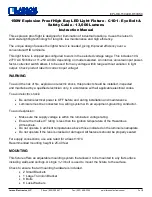
Q119
Sequential Controller
Aug 2014
Controls and Connectors continued...
Stop Button / Connector
This is a rising edge-sensitive signal used to stop the sequencer. Pressing this button (holding it is not
necessary) or applying a signal will cause the sequence to stop. The threshold of this signal is approxi-
mately 1.5 volts.
Set End Button
Allows setting of the end (last) stage in a sequence. Pressing the button switches to end stage selection
mode. The current end stage LED will flash. Continue to press the button to select the end stage. When
you have reached the desired end stage simply don’t press the button for 2 seconds.
Stage Controls / LEDs
Each stage has an LED to indicate when it is active (on) and a control which sets the output voltage when
that stage is active.
Bank Output / Gate
There are 3 banks of 8 stages each. These are important when in 3x8 mode. The output connector pro-
vides the voltage of the selected stage in that bank. If no stage is selected in that bank, the output is 0
volts. A gate output is provided when a stage is on. Gate signals are 0 volts when off, 5 volts when on.
Master Output Section
The master output section is important when in 1x24 mode.
Master Output Connector
The selected stage voltage is routed to the output connector. When in 3x8 mode all 3 stage’s voltages
are added together (mixed) and presented at the master output connector. The ‘Add’ connector voltage
and the ‘Add’ control are also added to the master output connector’s voltage.
Glide Control
Sets the glide (also known as slew limit) or gradual change between voltage levels. Set to full counter-
clockwise for no glide.
Add Control
Allows the operator to manually add to the master output voltage. The center position is 0 volts.
Add Connector
Allows an external signal to be added to the master output voltage.
Master Gate Connector / LED
Provides a gate signal which is controlled by the width control. Gate signals are 0 volts when off, 5 volts
when on. An LED indicates its status.
Done Output Connector
A signal provided when the end of a sequence is reached. Can be used to start other sequencers and to
control switches which select voltages to be routed to oscillators when stringing sequencers together.

























